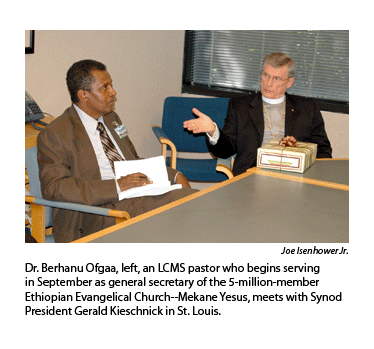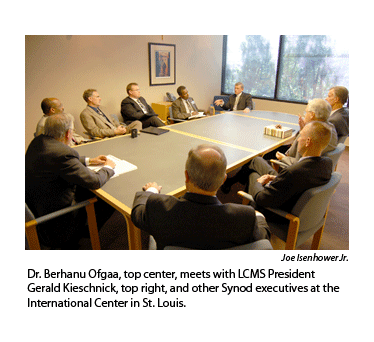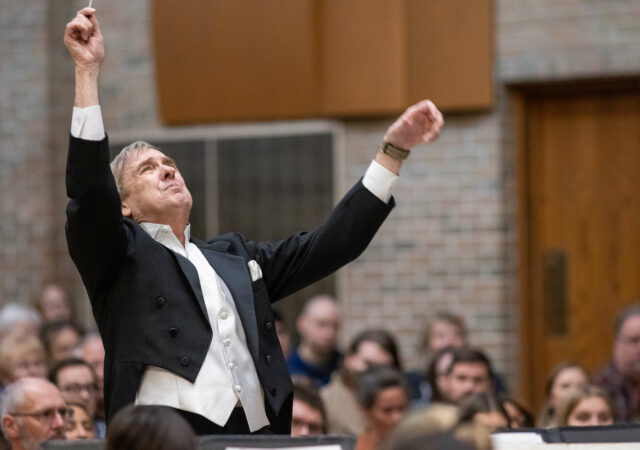Dr. Berhanu Ofgaa, an LCMS pastor elected to be general secretary of the largest Lutheran church in Africa, says his experience with the LCMS will strength en the relationship between the two church bodies.
en the relationship between the two church bodies.
Ofgaa, who is currently serving among African immigrants in central Ohio, told Reporter that his ministry “has helped me to deeply understand the relationship of these two churches, their theological understanding, and their missional interests.” He will return to Ethiopia in September to become general secretary of the Ethiopian Evangelical Church–Mekane Yesus (EECMY). With 5 million members it is the second-largest Lutheran church in the world.
“We are highly honored that an African Lutheran church body, much larger than ourselves, would elect an LCMS pastor to this important post,” commented LCMS President Gerald B. Kieschnick, who met with Ofgaa in early August. Following that meeting, attended by staff from the president’s office and LCMS World Mission, Kieschnick said, “We were happy to learn about Dr. Ofgaa’s service in the LCMS Ohio District and to hear about the challenges that are ahead in his service as the general secretary of the EECMY.”
As general secretary, he will be responsible for the administration of the church-at-large, serving next to the recently elected president, Dr. Wakseyoum Idosa. Ofgaa will have responsibility for supervising the implementation of resolutions passed by the highest decision-making bodies of the church, chairing the meeting of the management staffs, overseeing the operation of the joint programs like seminaries and medical activities, and coordinating the relationships with foreign agencies and missions.
Dr. Samuel Nafzger, LCMS director of church relations, welcomed the relationships that result from Ofgaa’s election. “We can learn much from a church that has gone through severe persecution at the hands of a Marxist government and has emerged with a strong and vibrant confession of the Lutheran faith that changes lives in Ethiopia,” Nafzger said. “We previously met with President Idosa, and we look forward to continuing discussions with these two men and their colleagues.”
In a telephone interview, Ofgaa said, “It has been both a learning process and a time of widening my view of cross-cultural communications, especially the time among the immigrants and the American church during my stay here.” While in the U.S., he became an LCMS pastor in 2002 through colloquy and has served as a missionary to African immigrants in central Ohio.
Ofgaa also completed a doctorate in missiology at Concordia Theological Seminary, Fort Wayne. He studied the organization of Ethiopian churches  in the U.S. and wrote his thesis on ethnic homogeneity and its impact on missions.
in the U.S. and wrote his thesis on ethnic homogeneity and its impact on missions.
“The issue of ethnicity and cross-cultural mission is one of the crucial issues of the church in Ethiopia,” Ofgaa said. “Ethiopia is a nation built up of over 80 independent language groups and 200 dialects. Because of the diversity of culture there are sometimes challenges in communicating with one another and communicating the Gospel.”
Prior to coming to the U.S., Ofgaa served eight years as president of the EECMY Central Synod (district) in western Ethiopia and eight years as president of the Central Ethiopia Synod, located in the nation’s capital, Addis Ababa.
Ministry among U.S. immigrants often will have an effect in their country of origin, commented Dr. Yohannes Mengsteab, director of new mission development with LCMS World Mission, who drew on Ofgaa’s expertise to develop U.S. strategies for immigrant ministry. Mengsteab added, “I’m sure this will result in stronger relationships with Ethiopia and the EECMY.”
Although the LCMS and EECMY do not have a formal partnership arrangement, Dr. Daniel Mattson, associate executive director for missional education with LCMS World Mission, is grateful that the two church bodies will learn from each other through work together. “Here we have an opportunity to grow in our relationship with a dynamic Lutheran church body that is two times larger than ours,” he said. “We are thankful for what we can learn from each other and in our work together.”
Posted Sept. 2, 2009




